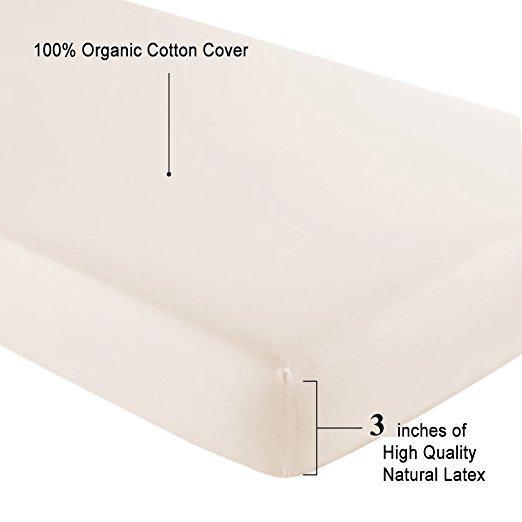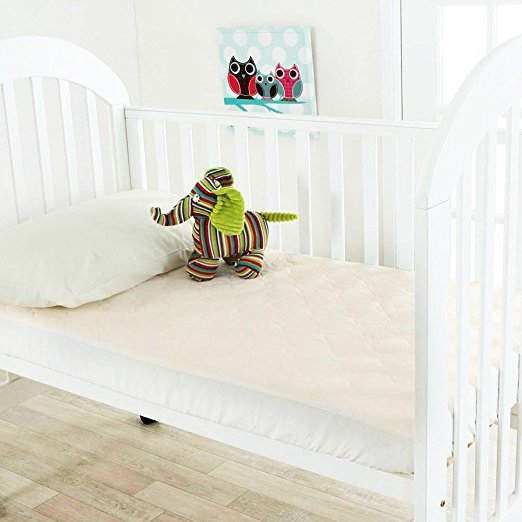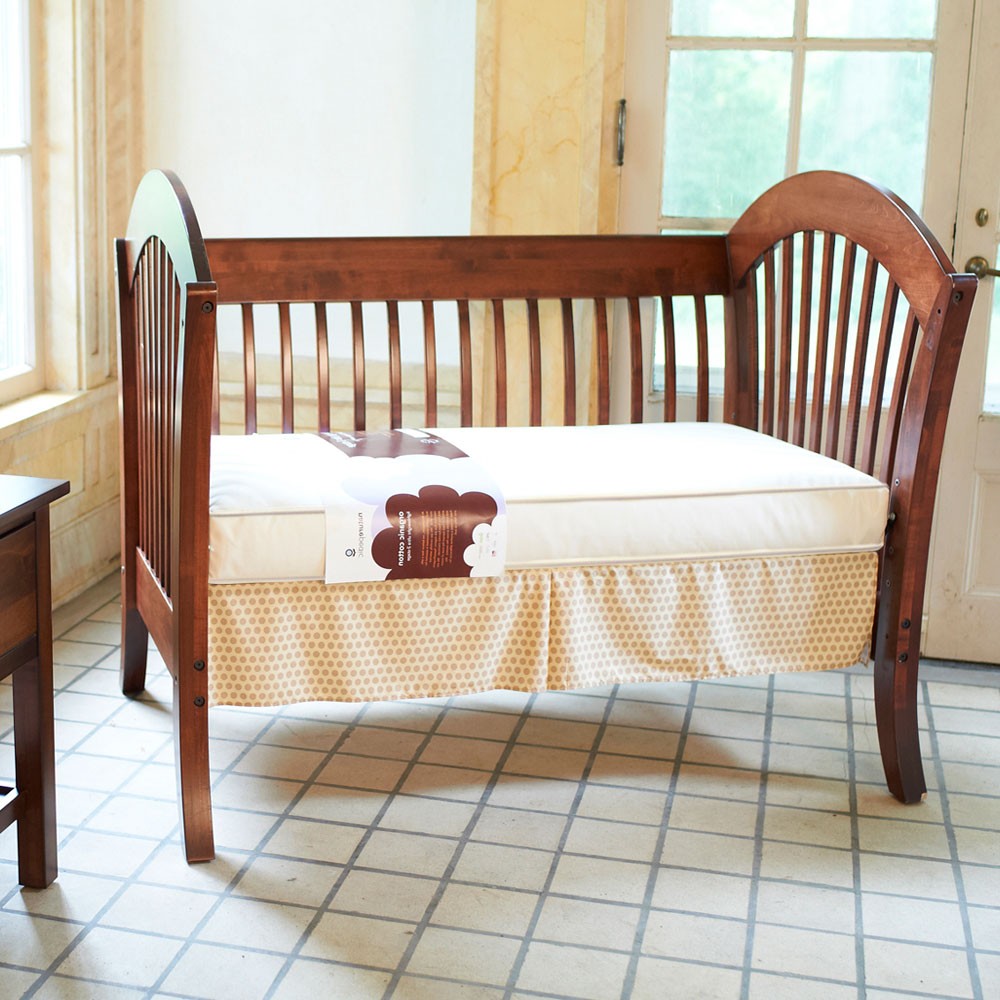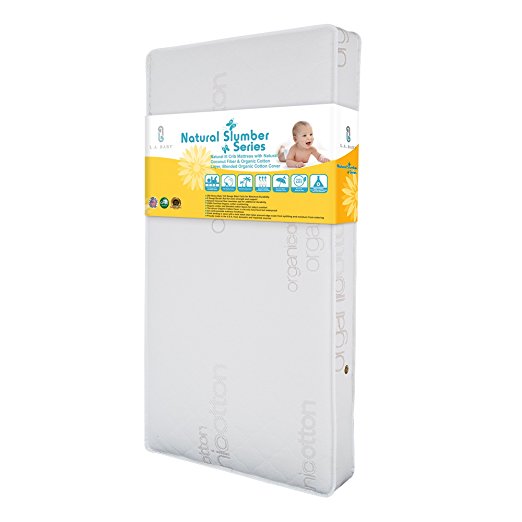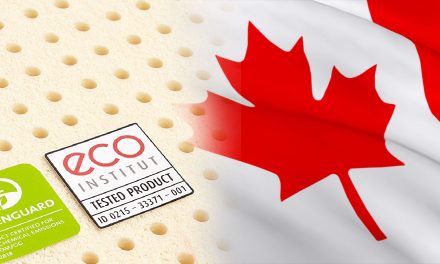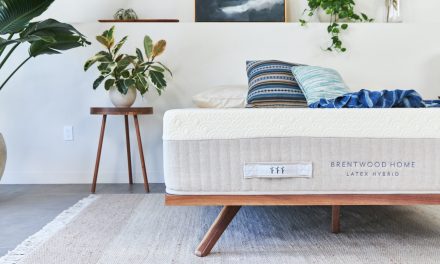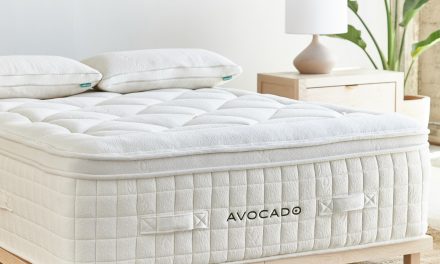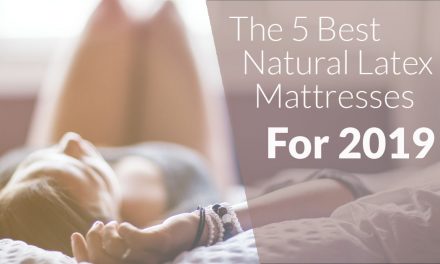Table of Contents
| Model & Brand | Visual | Check Latest Price | Dimensions | Firmness | Materials | Certifications | Made in: | Shipping | Check Latest Price | Visual | Model & Brand |
|---|---|---|---|---|---|---|---|---|---|---|---|
| Latex Crib Mattress by SleepEZ | 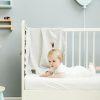 | 28 X 53 X 6 inches | Firm | Organic cotton, wool, Dunlop latex. | GOLS, Oeko-Tex, GOTS, Eco Wool, Eco Institut, Rainforest Alliance. | Made in USA | Free Shipping | 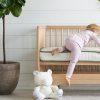 | Latex Crib Mattress by SleepEZ |
||
| Organic Crib Mattress by Avocado |  | 28 X 52 X 6 inches | Firm | Certified organic cotton, wool, latex. | GOLS, GOTS, Greenguard Gold, Oeko-Tex, | Made in USA | Free Shipping |  | Organic Crib Mattress by Avocado |
||
| Luxury Organic Crib Mattress by Avocado | 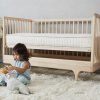 | 28 X 52 X 6 | Two sided: Infant side: firm Toddler side: medium-firm | Organic cotton, organic wool, Dunlop latex. | GOLS latex, USDA Organic latex, Oeko-Tex Standard 100, GOTS wool, GOTS cotton, | Made in USA | Free Shipping |  | Luxury Organic Crib Mattress by Avocado |
||
| Emily Crib by My Green Mattress | 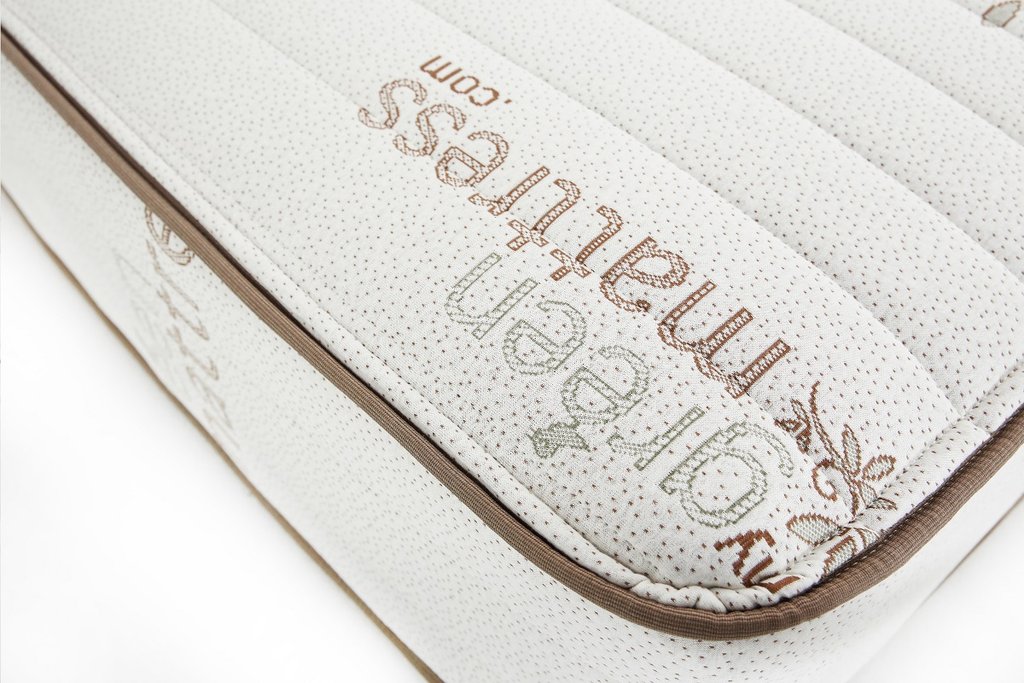 | 27.5 x 52 x 6 Inches | Medium | Cotton cover, wool padding, 150 13.5 gauge coils. | Greenguard Gold GOTS Cotton Oeko-Tex Wool | Made in USA | Free Shipping |  | Emily Crib by My Green Mattress |
||
| Certified Organic Crib Mattresses by Nest Bedding | 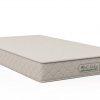 | 28 X 52 X 5 | Firm | Organic cotton, wool, Dunlop latex. | GOTS, GOLS, Greenguard Gold | Made in USA | Free Shipping |  | Certified Organic Crib Mattresses by Nest Bedding |
||
| Classic Organic Baby Crib mattress by Naturepedic | 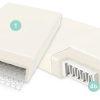 | 27 1/4" x 51 5/8" x 6" | Firm | Organic cotton w/ waterproof coating, PLA (sugarcane fiiber), organic cotton batting, innerspring or wavesupport™. | GOTS, Greenguard Gold. | Made in USA | Free Shipping |  | Classic Organic Baby Crib mattress by Naturepedic |
||
| Breathable Organic Baby Flippable 2-Stage Crib Mattress by Naturepedic | 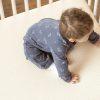 | undefined | 27 1/4" x 51 5/8" x 6" | Firm/Medium | Breathable organic cotton + cotton fill, waterproof coating (non-GMO sugarcane), PLA fiber on toddler side (non-GMO sugarcane), innerspring or wavesupport™ core. | GOTS, Greenguard Gold. | Made in USA | Free Shipping |  | Breathable Organic Baby Flippable 2-Stage Crib Mattress by Naturepedic |
|
| Organic Breathable Mini Crib Mattress by Naturepedic | 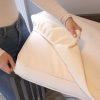 | 23.5" x 37.5" x 3" | Firm | organic cotton fabric + fill, non-GMO sugarcane waterproof fabric, non-GMO sugarcane waterproof layer, wavesupport™ core | GOTS, Greenguard Gold. | Made in USA | Free Shipping |  | Organic Breathable Mini Crib Mattress by Naturepedic |
||
| LaLa Memory Foam Crib Mattress by Essentia | 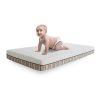 | 28 X 52 X 4.5 | Firm | Organic cotton, Dunlop latex core. | GOTS, GOLS, Oeko-Tex. | Made in Canada | Free Shipping to USA and Canada |  | LaLa Memory Foam Crib Mattress by Essentia |
||
| The Savvy Baby by Savvy Rest | 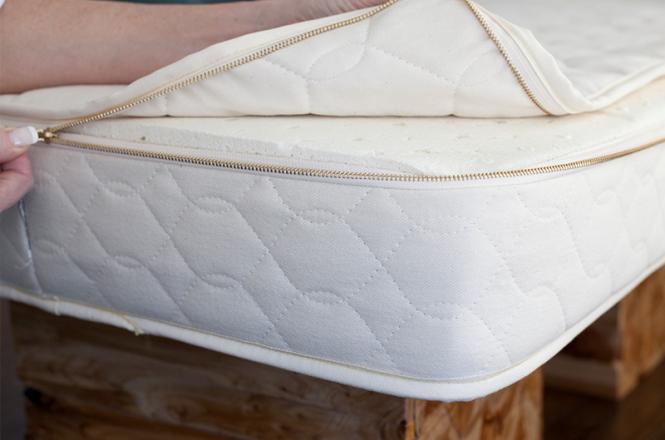 | 27.5 x 52 x 5 inches | Firm | Dunlop Latex, organic cotton. | GOLS Certified | Made in USA | Free Shipping | The Savvy Baby by Savvy Rest |
|||
| Natural III Crib Mattress by LA Baby | 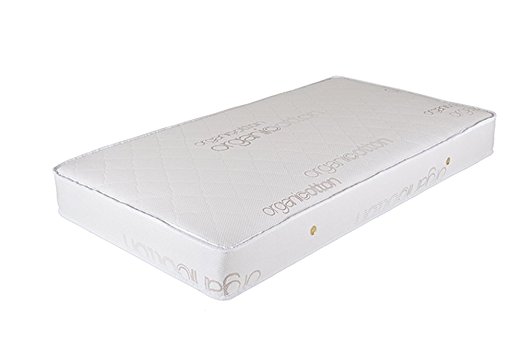 | 52 x 27.5 x 5.8 inches | Firm | Organic cotton, coconut fiber, 260 15.5 gauge coils, 9 gauge border rods. | USDA certified cotton | Made in USA | Free Shipping |  | Natural III Crib Mattress by LA Baby |
||
| Wovenaire Crib Mattress by Newton | 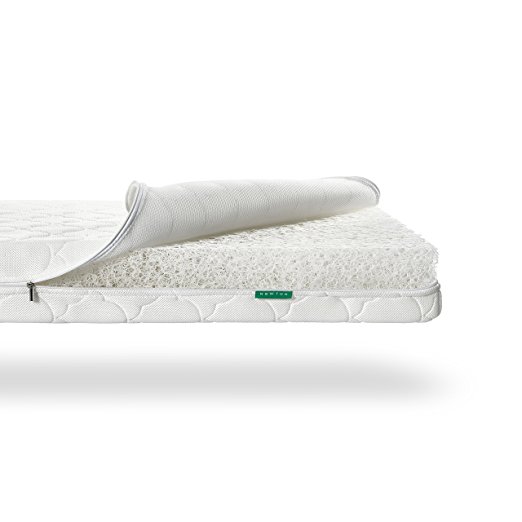 | 52 x 28 x 5.5 inches | Medium | Breathable fabric, food grade polymer. | Greenguard Gold | Made in USA | Free Shipping |  | Wovenaire Crib Mattress by Newton |
The environment inside our homes is becoming increasingly laden with all kinds of chemicals that may adversely affect your newborn. For most chemicals, no long-term studies exist to determine whether or not they present any adverse effects on your child. In light of this, caution is recommended when exposing your baby to synthetic materials and chemicals. That’s why it is advisable that your baby’s crib is fitted with a non-toxic mattress.
You might be aware of the negative impacts that conventional bedding can have on overall health. So, naturally, you would want to minimize your baby’s exposure to synthetic materials. Toxic chemicals found in polyurethane-based crib mattresses can adversely affect your baby’s health since it will be spending 10-14 hours per day sleeping on it. By sleeping for extended periods of time on a petrochemical-based polyurethane crib mattress laden with fire retardant chemicals, your baby could be absorbing some amount of toxic chemicals through the skin, mouth, and by breathing.
The key is finding non-toxic alternatives.
While replacing any potentially toxic materials with certified organic materials would be an ideal solution, it is not always cost-effective, or realistic. The key is to find the most non-toxic materials for your baby to sleep on without sacrificing practicality.
What I’m getting at here is that a non-toxic crib mattress must be easy to clean and durable. We all know diapers can leak in the middle of the night or your baby might regurgitate while in the crib. The last thing anyone wants is to work twice as hard to clean up the doo-doo.
The most important developmental period
Since your baby is in close contact with his or her crib mattress for an extended period of time on a daily basis, it is of utmost importance that he or she is not exposed to any toxic chemicals that could be off-gassing from toxic materials such as polyurethane foam or any other substance derived from petrochemicals.
The first few months of any child’s life are the most fragile, where the potential to develop chronic conditions is present. Therefore, there is no safe level of exposure to chemicals.
Why Choosing A Natural Crib Mattress Is Better For Your Baby
There are several benefits to choosing a natural latex crib mattress for your baby. Below are several reasons why you might want to opt for a natural or organic crib mattress.
- No off-gassing chemicals from polyurethane foam or vinyl covers
- No carcinogenic fire retardants
- Hypoallergenic – the materials are less likely to cause an allergic reaction
- Better for the environment – Natural crib mattresses contain many materials that are biodegradable and come from a renewable resource that provides many socio-economic benefits.
- More breathable – this will lower the chances of your baby being affected by SIDS (Sudden Infant Death Syndrome)
- Tested by third parties – Some crib mattresses are tested for chemical emissions by internationally recognized certifiers such as Greenguard and Oeko-Tex
Potential Toxicity in Conventional Crib Mattresses
Typically, the filling or padding material in a crib mattress is made of polyurethane foam. This is a material that is derived from petroleum and by nature is highly flammable. Various chemical additives are added during the manufacturing process depending on the desired outcome.
Chemicals include:
- Benzene – has been linked to hematopoietic, lymphatic, and breast cancer and may cause damage to a cell’s DNA.
- Flame Retardants – may cause thyroid disruption, cancer, DNA damage in cells, learning disabilities, lower IQ levels, and reproductive and nervous system damage.
- Chlorine – may cause respiratory illnesses.
- Formaldehyde – may be toxic to the respiratory system, developmental system, and immune system and contribute to causing cancer.
- VOCs – are linked to autoimmune conditions as well as damage to the kidney, liver, and nervous system and may lead to cancer.
- Solvents – may cause damage to the respiratory system, nervous system, reproductive system, liver, and kidney and cause dermatitis and cancer.
Toxicity Of Waterproof Crib Mattress Covers
Many crib mattresses are made with a waterproof vinyl cover to keep them clean from spills. Although practical, it is one of the most toxic plastics out there, and it’s all around us. Any thick, flexible plastic with the #3 recycling sign contains vinyl.
Vinyl is a type of synthetic resin and is technically identified as Polyvinyl Chloride. Since Polyvinyl Chloride is typically very rigid, chemical plasticizers referred to as phthalates are added to make it more flexible. This component of Polyvinyl Chloride or PVC accounts for 30-40% of the weight of the vinyl that is used as a crib mattress cover. Phthalates or some variation of them are present in most flexible plastics which are omnipresent these days.
Phthalates that are added to PVC vinyl have been linked to a number of health issues concluded by laboratory testing. These include:
- Metabolic disruption
- Liver, kidney, and testicular damage
- May lead to cancer
- Respiratory illnesses including asthma
- Endocrine disruption – this is the system in the body that is responsible for determining gender characteristics
In the United States, some phthalates have been banned. This is a step in the right direction. However, this has led to a marketing storm by manufacturers that have started to label their products as non-toxic or phthalate-free vinyl. These manufacturers are using chemical replacements or other phthalates that haven’t yet been banned but might be just as toxic.
No one is sure whether or not phthalates and PVC is safe for infants. When looking for a mattress that is labeled “non-toxic vinyl” or “phthalate-free vinyl”, the product likely contains chemicals to replace the phthalates in order to make the PVC more flexible. However, that doesn’t necessarily mean that they are less toxic.
Infants absorb chemicals in many ways
Toxic chemicals from polyurethane foam and PVC with phthalate additives can enter an infant’s body through the mouth, the skin, and the lungs.
A baby typically likes to chew on anything he can get his hands on. Sometimes, volatile organic compounds that are released from synthetic materials can bind to dust. This dust can fall on things like toys, pacifiers, or bedding. In turn, an infant can ingest minute amounts of chemicals through the mouth when biting on any of these objects.
Shortly after manufacturing is when materials such as polyurethane foam and vinyl release the largest amount of volatile organic chemicals. Since your baby sleeps 10-14 hours a day, he or she will be absorbing the chemicals through the lungs.
Absorption through skin contact is also possible, although this can be minimized by using a sheet as a barrier or by avoiding products with these chemicals altogether. Any soft plastic should be avoided. Things like rubber duckies are prime examples of PVC laden with phthalates and/or other plasticizers.
Continued exposure to PVC, vinyl, and polyurethane may lead to the child developing the following conditions:
- Liver and kidney damage
- Damage to the reproductive system
- Cancer
- Respiratory illnesses including asthma
- Early-onset of puberty
Fire retardant additives and fire barriers
By law, mattresses that are manufactured and imported to the USA must meet certain flammability standards. The material must be unable to support a flame and a certain amount of charring is allowed in order to pass the test.
Since most filling material in crib mattresses is made of highly flammable polyurethane foam, it is doused in flame-retardant substances in order for it to meet fire safety standards. But, what about repeated exposure to noxious chemicals? Well, in my personal opinion protecting someone from a raging fire is much more sensational than combating the long-term adverse effects of exposure to damaging chemicals.
Banned fire retardant substances replaced by other toxic chemicals
The most common flame retardants are brominated flame retardants or BFR’S. BFRs contain PBDEs or Polybrominated diphenyl ethers. These chemicals have been proven to bioaccumulate in the food chain and the human body. They accumulate in dust, blood, and breast milk and can cause many chronic illnesses which include cancer, hormone disruption, and developmental disorders.
Some highly toxic PBDEs have been banned from the European Union for many years, which explains why North Americans have higher levels of PBDEs in comparison to Europeans. Most mattress manufacturers in North America have voluntarily removed PBDEs from polyurethane because of the public outcry about its toxicity. The state of California has already banned it, and that had led many manufacturers and other states to follow suit.
The problem still remains
The move away from toxic and carcinogenic PBDEs is a win for consumers and their children. But the problem remains how do you fireproof polyurethane foam? Mattresses still have to pass government flammability standards and the core material is still made of highly flammable polyurethane foam or some derivative. companies must meet the standard regardless of the chemicals that are added to Fireproof polyurethane foam. In essence, the government flammability standard is King and there is little oversight placed on which chemicals are used to pass the flammability standard tests.
A New Player Among Flame Retardants
The phase-out of PBDE in 2005 in the United States has led to the rise of another dubious chemical called Tris. It is also referred to as TDCPP or 1,3-dichloroisopropyl phosphate.
A compound that is very similar to TDCPP tris(2,3-dibromopropyl) phosphate was used to be applied to children’s pajamas up until the late 1970s but was phased out. Children that were exposed to this chemical showed signs of mutagenic byproducts in urine samples. Children were especially susceptible to contamination because it can be absorbed by the skin.
The phasing out of Tris in wearable textiles didn’t dissuade furniture companies from using Tris as a replacement for PBDE. Their primary concern was to meet government flammability standards and get their products to market. In 2006, production in the United States of Tris (TDCPP) was between 4 500 and 22 700 metric tons. This classifies Tris as a widely used chemical in manufacturing. So, if you purchase a sofa, chair, or car in 2018 or later, assume that the polyurethane foam contains Tris (TDCPP) flame retardant.
The health risks of long-term exposure to furniture treated with Tris (TDCPP) include:
- Cancer
- Reproductive system damage in males
- Changes in normal development
- Negatively impact the development of the nervous system
- Impact on the thyroid and endocrine system which leads to an increased risk of ADHD and behavioral disorders.
In 2018 and beyond, the risk of coming into contact with TDCPP is ever-present. The chemical becomes volatile over time and is released into the air. It then binds to dust particles and further contaminates the home environment. Infants are especially prone to ingesting Tris (TDCPP) because they often put their hands in their mouths or chew on toys that have dust on them. The chemical also finds itself in the body by direct contact with the skin or by way of the respiratory system.
About SIDS (Sudden Infant Death Syndrome)
SDIS is one of the least understood causes of infant mortality. There are several theories that have been elaborated to explain the cause of SDIS, none of which are completely proven. I will attempt to mention a few here, not to disseminate fear and panic, but just for general awareness about the subject.
The most conclusive study about SIDS was done in New Zealand from 1985 to 2008. The study concludes that the most effective way to prevent SIDS is the “Back to sleep” campaign which simply says that babies should be placed on their backs while in the crib. During this campaign, SIDS deaths decreased from 4.19 deaths per 1000 in 1985 to 0.77 per 1000 in 2008.
To further decrease the number of deaths attributed to SIDS, the campaign suggests that mothers refrain from smoking during pregnancy and that the home environment should be smoke-free at all times.
Co-sleeping is contraindicated because the sleep surface of the parent’s mattress may be too soft and suffocation risks are much higher.
Parents and caretakers are advised to keep the crib free of loose soft articles and there should be no gap between the crib and the mattress.
A separate campaign in New Zealand suggests that parents wrap the crib mattress in plastic sheeting to prevent chemical gases from escaping. So far, the results of this campaign have been inconclusive. There are no studies that attribute SIDS directly to exposure to chemicals that are contained in polyurethane-based crib mattresses.
As far as crib mattress selection is concerned, the general consensus is that the crib mattress should be firm to prevent suffocation should the baby roll over onto the stomach.
Look for a “Non-Toxic” mattress
It can be stressful to find the perfect crib mattress for your precious child. With so many terms floating around like “non-toxic”, “safe”, “natural” and “organic” it can be a daunting task to tell which is best.
Some crib mattresses that are marketed as “organic” still contain materials that are toxic. For example, a crib mattress that contains organic cotton padding could be wrapped in toxic vinyl. Additionally, fire retardants could be added to the cotton or wool padding.
If you are unsure about the non-toxic qualities of a crib mattress, contact the manufacturer to find out if any of the natural materials are treated with fire retardants or any other harmful substances. Strive to find the most non-toxic crib mattress that can be purchased at a reasonable price.
Should you look for an organic crib mattress?
The term “organic” refers to how a plant or animal-based product is grown, raised, and processed in the agricultural industry. Organic products can be edible like cucumbers and carrots or non-edible like cotton and hemp fiber. Several agricultural organic standards exist in the US such as USDA organic.
By definition, crib mattresses cannot be organic because some of the materials that are used such as the metal inner springs and the waterproof covering are non-organic. Certified organic products have fibers and are plant or animal-based and are supplied by producers in the agricultural sector.
In light of this, only certain materials within a mattress can be certified organic.
Organic Cotton Materials
You will notice certain mattress models contain organic cotton. This is cotton that has been grown without any pesticide or fertilizer treatment. Mattresses that contain an organic cotton layer have a definite advantage. Cotton is one of the most highly sprayed crops and the chemicals build up in the cotton fiber. Therefore, you are still exposed to the chemicals, even after the cotton has been harvested.
Buying products that contain organic cotton benefits the environment by preventing toxic runoff from crops. The health and safety of the plantation workers and neighboring inhabitants are also ensured.
Organic Wool Materials
Organic wool means that the sheep or goats were fed organic feed that was grown without the use of synthetic fertilizers or pesticides. Organic wool producers also have to follow strict guidelines on how they ethically tend to the animals. Standards also exist to ensure adequate living standards for the animals that provide the wool.
Furthermore, organic wool is washed and processed without the use of toxic dyes, cleaners, or toxic chemicals.
Certification
In the agricultural sector, the USDA Organic is a widely recognized certification for food and raw materials like wool. This certification cannot be applied to mattresses because it is made of materials that are not from the agricultural industry.
There are standards that have been created for finished products that include mattresses and furniture and apparel. For products in the mattress industry, the most widely recognized certification is provided by GOTS (Global Organic Textile Standard).
The GOTS standard requires that all textiles within a product be approved and certified by the National Organic Program (NOP). Non-organic components such as metal coils inside the mattress must meet non-toxic standards established by GOTS. This ensures that all the components within the mattress are non-toxic.
Other certifications you might come across while researching crib mattresses are Euro Latex, which certifies only the latex foam layer. Another prevalent certification is OEKO-TEX, which has similar standards to GOLS.
Beware of mattresses labeled as “Eco-Friendly” Or “Green”
The rise in popularity of being environmentally conscious in nutrition and lifestyle has created an alternative market across all industries. Manufacturing companies have noticed this trend and have been eager to cash in on this growing market. Many mainstream companies that weren’t at all concerned about the environment now have a line of products with some environmental angle that makes them attractive to eco-conscious people. “Eco-Friendly” and “Green” have become buzzwords for marketers across all industries.
For example, I had part of my house insulated with urethane spray foam. The name of the product that the insulation contractor applied was called Airmetic Soya. Having the “soya” right in the name makes it sound pretty natural and harmless, doesn’t it? Well, I later found out that the soy component in the product accounted for only 10 – 15% of the mix. Makes you wonder why the manufacturer used the “soya” word in the name of the product, even though the product is at least 85% petrochemicals.
Marketing “Green” Products Is Present In The Crib Mattress Market As Well
Just like in my urethane foam example, manufacturers in the mattress industry use the same eco-hijacking marketing tactics for mattresses. You may have come across names like Eco Foam, Soy-based Foam, or Bio Foam. These mattresses are just like any other conventional polyurethane foam mattress, except that the foam contains 5 – 15% of soy or plant-based oil. It’s almost as if the manufacturer’s only intention is not to make a better product but to be able to market it as “plant-based”, “green”, “eco-friendly” or by any other term that has an environmental connotation.
Currently, there are no regulations that control how a bedding product is marketed, how it is named, or how it is described. A company can market a mattress as “Eco-Friendly”, “non-toxic” or “safe”, even though it has just about the same amount of VOCs and toxic flame retardants as any other polyurethane mattress. Thankfully I’ve weeded out the crib mattresses of companies that make dubious claims about their health, safety, and environmental benefits. You’ll find my list of the best non-toxic crib mattresses below.
Additionally, since these “soy-based” foams are mostly made of polyurethane, they are extremely flammable and require the application of chemical fire retardants in order to pass flammability requirements.
Another sly marketing tactic you may come across is crib mattresses that have bamboo covering. Let’s face it, everyone loves bamboo trees. You can make countless stylish things out of them and even more, they’re associated with Koala bears, which are so cute.
However, the actual amount of bamboo in the fabric is minimal. The rest of the fabric is usually cotton or polyester fiber. The manufacturer’s tactic in this instance is the same; integrate a small amount of X renewable material and call the finished product that very same thing. Notice a pattern starting to form here?… I thought so.
Crib Mattresses: What’s Inside?
Natural Latex
Many non-toxic crib mattress manufacturers use natural latex as the padding layer. Natural latex foam is made from the sap of the Hevea Brasiliensis – Rubber Tree. The trees grow on plantations in Indonesia, South America, and Africa. After the sap is harvested, it is frothed up and steam baked in a mold.
Incidentally, some non-toxic chemicals are used to stabilize the latex before it is made into foam. However, the small amount used is worlds apart from the amount present in a typical polyurethane mattress.
Similar to other materials mentioned in this article, natural latex foam has been subject to “green hijacking” by synthetic latex foam manufacturers. In order to avoid getting hoodwinked into buying a “natural latex” foam mattress that is actually mostly synthetic, make sure that the mattress is GOLS or Euro-Latex Certified. The GOLS (Global Organic Latex Standard) ensures that the foam contains at least 95% raw material. The certification also requires standards to be met during the entire production chain from the plantation to the finished product.
There can be allergic reactions to natural latex, however, the risk is much higher when the latex is in direct contact with the skin. The proteins within the natural latex are what cause an allergic reaction. Therefore, if the latex foam layer is a component of the mattress and is encased in a covering material, the chances of it triggering an allergic reaction are unlikely.
Recently, advances have been made in the manufacturing process to remove the allergy-triggering protein in the latex sap. Vytex Natural Rubber is a company that has pioneered this process and currently manufactures toppers and mattress inner layers. So far, I haven’t seen any crib mattresses that use Vytex foam.
Wool
Wool is an excellent padding layer and fire barrier since it does not support a flame. Wool is dust mite resistant because of the microscopic bristles on the wool fibers. Additionally, it is anti-microbial and anti-bacterial.
Some people, less than 1% are allergic to the lanolin in the wool. Lanolin is a wax secreted by animals to give the wool its water-wicking and fire-suppressing qualities. Other allergic reactions to wool are mostly due to the way the wool is processed after it has been cut.
If you have concerns about your baby’s sensitivity to wool, you can have it near a wool garment and see if there is any reaction. Note that the wool layer is found on the inside of the mattress and is covered by a soft outer layer and bedsheets.
Cotton
Cotton is a superb padding material because it is soft, breathable, non-toxic, and comes from a renewable resource. It does not support a flame, similar to wool. Some mattresses in India are still made entirely of cotton padding.
Food Grade Polyethylene
Imagine a crib mattress that does not contain any foam, metal springs, adhesives, or glue and that is also hypoallergenic and non-toxic. Additionally, it is Greenguard Gold certified. Wovenaire is a patented technology that weaves food-grade polyethylene into a three-dimensional mesh. There is no chemical reaction that takes place to make the Wovenaire layer, so there are no off-gassing chemicals to worry about.
Waterproofing Your Non-Toxic Crib Mattress
It is essential to waterproof your baby’s crib mattress to protect it from wetness. Leakage from diapers, regurgitating, drooling, etc, can damage the mattress. If not cleaned properly, the mattress can develop fungus, mold, mildew, and bacteria. This can be toxic to your baby, so it is important to keep the mattress clean.
Some mattresses come ready-made with a waterproof covering, but it’s always a good idea to add one. Look for covers that don’t have any vinyl as part of the materials.
A worthwhile alternative is a mattress cover that is made of stretch knit polyester that is laminated with urethane. This type of material has many other applications for baby apparel and is often referred to as PUL (polyurethane laminate fabric). It is the same material that is used for the waterproof shell of reusable, washable cloth diapers.
Unfortunately, no known natural material can completely waterproof your infant’s crib mattress. You will likely have to use some sort of plastic sheeting or a crib mattress cover that has a PUL layer in it. Yes, it goes against the concept of having a 100% natural baby bed, but it is the lesser of two evils, as the mattress will be protected against mold, mildew, fungus, and bacteria.
If you would like to watch my review of the best non-toxic & natural baby crib mattresses, check out the video below
Non-Toxic Crib Mattresses
 100% Natural Crib Mattress Topper
100% Natural Crib Mattress Topper
- A softer feel for toddlers
- 100% Natural 3″ Natural Latex Topper
- Organic cotton cover
- All-natural materials
- Hypoallergenic, antibacterial, antimicrobial, and dust mite resistant
- Firm mattress 28-30 ILD
The 100% Natural Crib Mattress Topper by Organic Textiles is a great way to spruce up your existing crib mattress setup. It is a cost-effective way to add a non-toxic layer to a crib mattress that is aging but still has many good years of use left in it.
You might also want to use this topper as a transition mattress for your toddler before he or she moves to a full-size bed. It is slightly softer than a crib mattress but firm enough so that it’s safe for sleeping. Simply lay it on top of a firm crib mattress and you’ve got the perfect setup for a toddler or a young child.
Another great application for this topper is as a floor mattress for naptime in a daycare setting. It is lightweight and will keep your daycare free of VOCs and toxic chemicals. Additionally, it will last much longer than a polyurethane mattress. Be sure to have an adequate protective non-toxic cover if using this topper in a daycare.
This topper is all-natural and does not contain any polyurethane, synthetic foam, vinyl, phthalates, or polyethylene. It will not off-gas volatile organic chemicals into your toddler’s sleeping environment.
The 3-inch natural latex topper from My Organic Textiles is available in three different covering materials. You have the choice between Organic cotton, wool, or bamboo.
Note that this topper is not waterproof. Organic textiles make a waterproof liner that fits the topper perfectly. Use a cover to keep the topper in pristine shape.
No Compromise
by Naturepedic
- Organic cotton waterproof fabric
- Organic cotton filling
- Coil support layer
- Decorative trim
- Square corners for a snug fit in the crib
- PLA fireproof batting as a flame retardant
- Metal rods for side support
This is a heavy-duty innerspring crib mattress that is built to last. It is firm, waterproof, and provides your child with a non-toxic sleep surface.
The waterproof layer is made of polyethylene. It is easy to clean and it is food-grade. This means that it is used for packaging in the food industry. It has a very simple cell structure and does not require any additional toxic chemicals to make it supple as is the case with vinyl and PVC. These plastics require the use of toxic phthalates. The waterproof polyethylene barrier also acts as a barrier against dust mites and bed bugs.
The cotton cover is certified USDA organic and adds some softness to the cover layer. In turn, this supports U.S. cotton producers.
The No Compromise crib mattress features 150 individual coils as a support layer. A 250-coil option is also available. This coil layer ensures a firm surface so that your baby can safely rest.
 Natural III Crib Mattress
Natural III Crib Mattress
by LA Baby
- 260-count coil support layer
- Natural coconut husk support layer
- USDA 100% organic cotton padding layer
- 9 gauge border rods for added strength and side support

The Natural III crib mattress is proudly made in the USA from domestic and imported materials.
Wovenaire Crib Mattress
by Newton
- 100% breathable and washable crib mattress
- Greenguard Gold Certified
- No polyurethane foam, latex, springs, or glue
- Hypoallergenic
- 100% recyclable
- Made in the USA
- For infants and toddlers
The Newton crib mattress is a completely breathable and washable crib mattress. It is made with a patented Wovenaire core layer fitted with a breathable and washable cover layer.
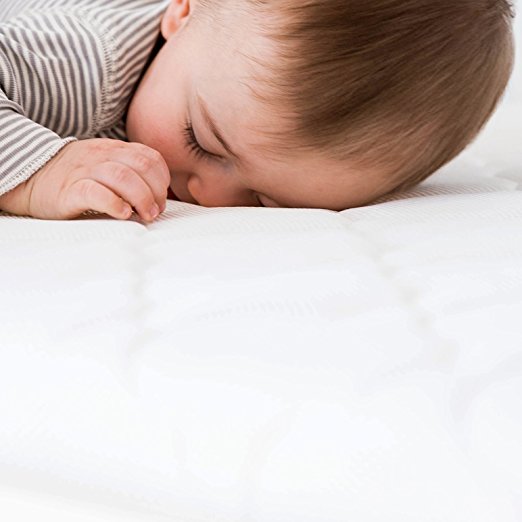
Having a completely washable cover and inner core means that you can keep it clean should any messes occur. And the cover material actually prevents bacteria growth. To wash the core, simply immerse in the bathtub in cold water. The cover can be machine washed in cold water and tumble-dried on the low heat setting.
The volume of the inner core is 90% air and 10% food-grade polymer. The core is wrapped in breathable, zippered fabric for easy removal and washing.
The Newton crib mattress has received excellent reviews on Amazon with hundreds of satisfied parents of well-rested babies.
Emily Crib
- Certified by Greenguard Gold for low emissions
- Gots certified cotton
- Oeko Tex certified American wool
- Organic cotton batting
- Wool fire barrier
- Naturally resistant to dust mites, mold, and mildew
- Double-sided (same firmness on both sides)
- Handcrafted in the USA
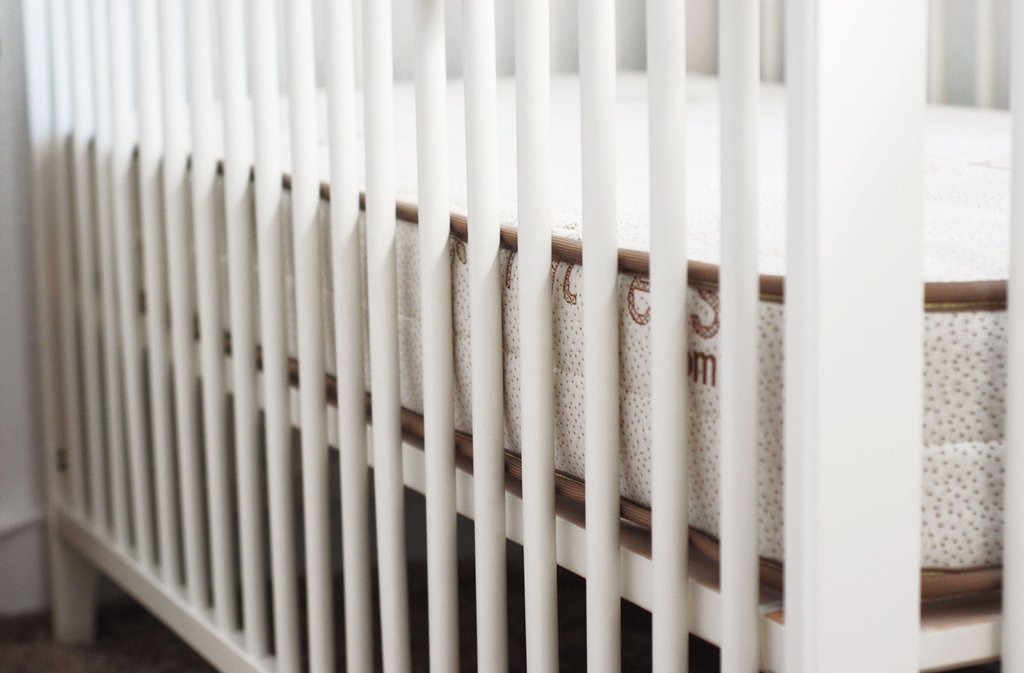
Your baby won’t be exposed to any toxic flame retardants as the fire barrier is provided by the Eco-wool layer that is sourced from California and Oregon. This mattress does not contain any polyurethane foam, which nearly always has toxic fire-suppressing additives within it.
The Emily Crib mattress ships straight to your door via FedEx and is guaranteed against any manufacturer’s defects for 10 years.
The Savvy Baby
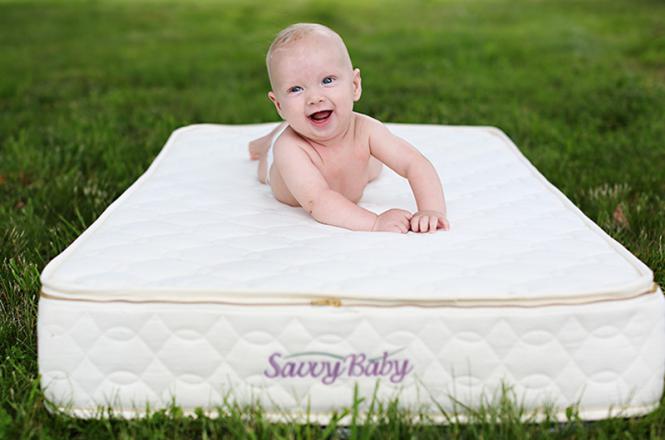
- GOTS certified from top to bottom
- Natural Latex Core
- Organic Wool Fire Barrier
- Certified organic cover
The Savvy Baby crib mattress features a natural latex core that does not contain any synthetic latex or fillers. The core is made from Rubber Tree sap in the Dunlop manufacturing method. The result is a firm and supportive core layer.

The wool layer promotes airflow as it is highly breathable. It also acts as an effective fire barrier. With a natural wool fire barrier, the Savvy Baby mattress can meet flammability requirements established by UL (Underwriter’s Laboratories) without the use of toxic flame retardant chemicals.
Customers have been raving about the amazing customer service at Savvy Rest. The staff is always there to help with any questions or concerns about the Savvy Baby crib mattress.
In Conclusion
If you’re looking to simply spruce up a worn crib mattress and you want a non-toxic option, the 100% Natural Crib Mattress Topper by My Organic Textiles is a great option. You can make that worn crib mattress good as new with the My Organic Textiles Topper. Additionally, you’ll be sprucing up that crib mattress with a topper that doesn’t contain any VOCs or toxic fire retardants.
If you’re used to a traditional crib mattress with an inner coil layer for excellent support, breathability, and responsiveness, the Emily Crib, and the Natural III Crib Mattress are fantastic options.
For a 100% natural latex core without the spring layer, the Savvy Baby by Savvy Rest is your solution.
Finally, for a space-age, 100% washable, non-toxic crib mattress, check out the Wovenaire Crib Mattress by Newton. Satisfaction among parents for this crib mattress is among the highest in my lineup. Check out what parents are saying about the Wovenaire non-toxic crib mattress here.

